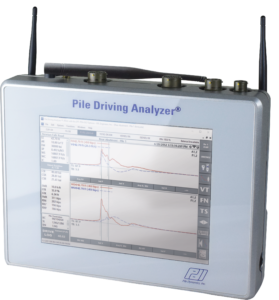How many PDA-8G tests are typically required in the USA?
For highway projects, the American Association of State Highway Transportation Officials (AASHTO) LRFD guideline stipulates that the required number of tests with the PDA-8G is 2% of the total number of piles on the job, or 2 piles — whichever is larger. Typically, the latter is larger because most bridges have very few piles per pier. This results in higher resistance factors (lower equivalent safety factors) than projects controlled by static analysis, dynamic formula, or even wave equation analysis. Testing with the PDA-8G testing lowers the overall cost of the foundation. Furthermore, testing 100% of the piles results in even higher resistance factors (lower equivalent safety factors) under the AASHTO’s LRFD code. This produces even more economic benefit. This testing method has become increasingly common in Florida.
For private sector projects, the IBC code treats dynamic testing (ASTM D4945) and static testing (ASTM D1143) as equivalent. In addition, this code does not provide general guidance on the amount of testing. Instead, the code asserts that testing 5% of piles is reasonable. Moreover, the code indicates that even testing 10% is not unreasonable.
The Australian LRFD code AS2159 gives higher resistance factors (lower equivalent safety factors) when higher percentages of piles are tested. This yields a larger benefit. Testing 5% to 10% of the piles is not unusual. Under the Australian code, however, testing more than 25% of the piles does not yield any additional benefit.
Return to FAQs



